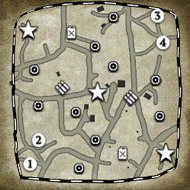oh yeah i used anything i liked from every corner of sets, my map have it all lol . . . what u mean by "bunch making land bridges" ? i was experimeting with bridges 1st time i think i have just 5 of them. is it functioonal if they just stick on each shores , or are there some additional options to it ?
To see if the problem was pathing related, I connected each bend of the map using normal terrain height adjust. Usually those new paths were blocked by objects so I deleted a bunch of objects to clear the way.
. . . so du u reccomend me to bring down the number of objects to 3000 ???
Like I said earlier, you are in uncharted terrain
 I would start by going into the blueprint list and deleting all of the buildings from one of the building sets and then test. See if it makes a difference.
I would start by going into the blueprint list and deleting all of the buildings from one of the building sets and then test. See if it makes a difference.I think most of the knowledge about mapping is from trial and error testing. There is not an official RELIC document with guidelines? There may have been knowledge passed down from Relic devs etc in the past.
Some of the myths/legends/facts gathered thru the ages are:
- Multiple water sources require multiple draws of the map for reflections and could slow your FPS.
- Multiple building sets is bad because it is believed Relic loads the entire set into memory. So having four sets is similar to loading two or three maps into memory at once.
These may be true. If so, I would start with the building removal. If not, it will make no difference.


 United States
United States
 And Kubels are just invisible and cant be used at all.
And Kubels are just invisible and cant be used at all. Lion king
Lion king
 Private Mok
Private Mok









 보드카 중대
보드카 중대  Heartless Jäger
Heartless Jäger 